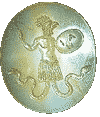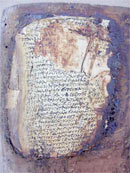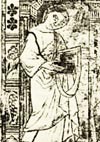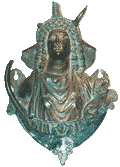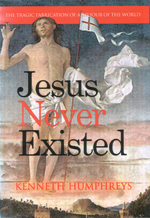Spirit in the Sky
For early Christians, Christ had NO physical existence. For them, he was not born, nor did he die.
"Jesus" in the early Gnostic gospels (Gospel of Thomas, Odes of Solomon, etc. ) is a teacher, a guide to spiritual development. He is placed in no historical context nor is he crucified.
Christ was the spirit or wisdom of God, present in all things. To attain self knowledge was to know "Christ."
The first Christian books – earlier than the synoptic gospels.
52 manuscripts, sewn into 13 books ... a priceless Gnostic library, hidden from the pyromaniacs of orthodoxy for 1600 years
Cave at Nag Hammadi, Upper Egypt
Codex I
1. The Prayer of the Apostle Paul
2. The Apocryphon of James
3. The Gospel of Truth
4. The Treatise on the Resurrection
5. The Tripartite TractateCodex II
6. The Apocryphon of John
7. The Gospel According to Thomas
8. The Gospel According to Philip
9. The Hypostasis of the Archons
10. On the Origin of the World
11. The Exegesis on the Soul
12. The Book of Thomas the ContenderCodex III
13. The Apocryphon of John
14. The Gospel of the Egyptians
15. Eugnostos the Blessed
16. The Sophia of Jesus Christ
17. The Dialogue of the Saviour
Codex IV
18. The Apocryphon of John
19. The Gospel of the EgyptiansCodex V
20. Eugnostos the Blessed
21. The Apocalypse of Paul
22. The Apocalypse of James
23. The Apocalypse of James
24. The Apocalypse of Adam
32. Fragment of the Perfect DiscourseCodex VII
33. The Paraphrase of Shem
34. The Second Treatise of the Great SethCodex VI
25. The Acts of Peter and the 12 Apostles
26. The Thunder, Perfect Mind
27. Authoritative Teaching
28. The Concept of Our Great Power
29. Plato's Republic 588A-589B
30. The Discourse on the Eighth and Ninth
31. The Prayer of Thanksgiving
35. The Apocalypse of Peter
36. The Teachings of Silvanus
37. The Three Steles of Seth
Codex VIII
38. Zostrianos
39. The Letter of Peter to PhilipCodex IX
40. Melchizedek
41. The Thought of Norea
42. The Testimony of TruthCodex X
43. MarsanesCodex XI
44. The Interpretation of Knowledge
45. A Valentinian Exposition
46. Allogenes
47. HypsiphroneCodex XII
48. The Sentences of Sextus
49. The Gospel of Truth
50. Unidentified fragmentsCodex XIII
51. Trimorphic Protennoia
52. On the Origin of the World
Hidden at Nag Hammadi, Upper Egypt, Gospel of Thomas
Cerinthus
At a time when Jewish "elders" were trying to restore the ancestral faith, an Alexandrian Jew, Cerinthus, rejected the whole 9 yards of the Torah, dietary laws and circumcision and set up shop with a Jesus who was a normal man "in whom the spirit had entered at baptism."
Clement of Alexandria tells us that Cerinthus and the "apostle John" were contemporaries and rivals.
Bizarrely, the so-called Revelation of St John was said to be the work of the heretical Cerinthus – before, that is, it was accepted into the canon as God's inerrant word!
"Homoerotic-initiation-rite Jesus"
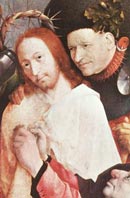
Cozying up to Jesus
Carpocrates
A follower of Cerinthus, Carpocrates, took the fable off in a whole new direction. Again, according to Clement, in a letter to someone named Theodore, Carpocrates had stolen a copy of "secret Mark" and had distorted it for his own cultic purposes.
It seems the Carpocratians practiced homosexual initiation rites, which they claimed Jesus had originated.
Carpocrates said good or evil was simply a matter of opinion and souls were saved by God's grace alone. And if heresy hunter Irenaeus is to be believed the Carpocratians reasoned that in order for souls to progress bodies should have experienced everything imaginable. Thus, there is absolutely no reason to refrain from every imaginable vice. Wow!
|
|
|
|
Truth?
One of the most important documents discovered at Nag Hammadi in 1945 was the Valentinian Gospel of Truth, possibly a work by Valentinus himself.
In the theology of Valentinians ultimate reality was a procession of 'aeons', 33 in all, issuing in pairs from the primal silence.
Emerging from the aeons came 'mind' and 'truth', in turn engendering 'the Word' (Logos) and Life.
The thirtieth aeon, 'Sophia', at length, gave way to the last three aeons – Christ, the Holy Spirit, and Jesus the Savior, the true son of Mary and Joseph, upon whom the 'Spirit of the Thought of the Father' (or Sophia), had descended in the form of a dove.
Ultimately, the Valentinians were doomed. Esoteric and 'learned', its doctrines were too rarified for the coarse requirements of a State religion for the illiterate masses.
February 2005
New Hidden Trove of Forbidden Gospels Found!
Al-Gurna, Luxor – Excavators unearth two papyri books containing over 100 pages of Coptic text.
"It is a very important discovery, equal to the Nag Hammadi scrolls."
– Zahi Hawass, secretary-general of the Supreme Council of Antiquities.
Ebionites: "Jews for Jesus, Paul a Heretic"
The Jewish Christians of Palestine had been caught in the crossfire between the insurgents of Bar Kosiba and the Roman army.
In the aftermath of the war, when the Gnostics condemned the Jewish God as the Demiurge, many of the brethren were unhappy.
They clung as best they could to their Jewish roots and the Mosaic Law. Paul's writings, with their celestial hero, were the deceits of a heretic.
Two factions appear to have existed, the Ebionites (aka Symmachiani) and the Nazarenes (Epiphanius, Haeres., 30). Both dismissed the pagan notion of a virgin birth and reaffirmed a strict monotheism.
Thus Jesus became just a man, albeit the chosen one, possessed by the Spirit at baptism:
The cults existed between the 1st and 5th centuries and influenced both the Mandaeans and Islam.
Pagan Christs?
Snake-Jesus
Caduceus – Ancient and modern symbol of 'healing'.
From the 6th century until the Renaissance the Christians used the urine flask as the sign for what passed as "medicine."
Mainstream Christianity maintains the deceit that its collection of Jesus anecdotes and incidents are reports of actual comings and goings of their godman and were told "from the beginning" by his followers and fans. Collectively
they buttress the falsehood that what passes for mainstream Christianity
or "orthodoxy" originated with
JC himself (rather than in the 4th century with the newly empowered
hierarchs
of the Church).
Custodians of Wisdom
Always a common thread to their message was a duality between the material world, which they denigrated and despised, and a conjectured spirit realm held in sublime esteem. The pious fantasising, elaborated at length by adepts of a "higher wisdom", spread through an empire which had excellent communications and a despairing underclass. Dozens of factions contended and gospels of fantasy and fancy proliferated.
Secret knowledge?
Inner mystery, Outer Mystery Christian Gnosticism was an enthusiasm of the wealthy and comparatively secure landowning and merchant class. It arose from Jewish Gnosticism in the wake of the Jewish wars, which culminated in the utter defeat of the Jews in 135 and the erasure of a Jewish state. The Mediterranean ports were flooded with despised Jewish refugees and the slave markets overflowed with Jewish captives. God had shown 'His displeasure' not only with them – but with all things Jewish. Many early Christians migrated to Rome in the wake of the Jewish war. Among them was Valentinus, Marcion, a wealthy ship owner from Pontus, and Cerdo, who established a school in which the new theology was taught. The gnostic leaders openly proclaimed that all things Jewish should be discarded. They declared that the God of the Old Testament was an inferior god, the deity of the lower, material world. Having jettisoned "Jewish practices", familiarity with the Greek "mystery religions" led the Gnostics to copy their style. Within an inner circle of adepts a secret "higher Wisdom" was passed orally from Master to Initiate. Their claim to authority rested on earlier holy men, apostles and sages, who, it was said, had entrusted arcane knowledge to their favourite disciples, the founders of the gnostic sects. The cults, as competitive clubs, vied with each other for acolytes, with some groups committed to asceticism and the denial of all "pleasures of the flesh" and others to indulgence, in which sex, revelry and all manner of dissolute behaviour were encouraged. Their common goal was to find "the Christ within."
Pageant and Pantomime The exclusivity of mystery cult meant that gnosticism was intrinsically elitist. But for the uneducated rabble, the Gnostics had something powerful to offer. What they presented to the unsophisticated, non-elite, were vulgarised versions of gnostic doctrines dressed up in allegory. Written down and circulated, the allegories were subsequently enacted in pageants and plays, in which characters took on the role of unseen Powers and Principles. Personification of the abstract was standard fare in the Roman theatre.
These talented Christian leaders of the mid-2nd century concocted fables, each styled the "one true gospel of the Lord", with which they made a bid for a more universal leadership. The more ambitious strove for an independent, even millenarian church; some achieved high position within the Catholic hierarchy. Thus began the process of anthropomorphizing, in particular, the Wisdom or Word of God into a human figure, a Jesus Christos, about whom, a series of anecdotes, ‘reminiscences’ and stories would be woven. Simon the Magician The Samaritan "Simon the Magus" was an early Jewish Gnostic who inspired both the mystical "Kabala" (a refinement of Pythagorean "magic" numbers) and later Christian Gnostics – Basilides, Saturninus, Carpocrates among them. Later Catholic writers demonized the poor guy. He may actually be the figure on whom the apostle Paul is based! Simon goes unmentioned in the Gospels but in Acts he has "bewitched" all the people of Samaria.
Whatever the reality of Simon's bewitching power the following dozen verses of Acts packs in a host of nonsense: Simon's conversion by the deacon Philip (but not really); the arrival of the heavies Peter and John; Simon's offer of money for the power of Holy Ghost; Peter's curse and Simon's final plea for forgiveness. For centuries, the Christians kept up the attacks on Simon, weaving into the fantasy Helen of Troy and/or a prostitute called Helena, Nero (who else!) and a battle of magic with Peter. What we might reasonably conclude from all this is that a charismatic holy man of Samaria gave the early Christians some stiff competition.
Valentinians: "Resurrection from Ignorance ..." Valentinus was nearer to the "Jesus action" than most other Church Fathers. Born in Phrebonis in Upper Egypt about 100 AD, Valentinus's claimed spiritual guide was a certain Theodas, who, it was said, received his doctrines directly from St Paul – significantly, not a human Jesus! Like Paul and many other early Christian mystics, Valentinus claimed that he had experienced a vision of Christ. Valentinus was still a young man, studying in the city of Alexandria, when an insurrection by Egyptian Jewry had been answered by savage Roman reprisals. With their urban and religious organisation shattered, remnants of Egyptian Jewry sought religious salvation anew. Within three years Valentinus was able to present them with his "Christianity." Following his supposed 'vision', Valentinus began a career as teacher/shaman – first at Alexandria, around 120, and later in Rome. Yet there is little of the familiar Christ myth in the Valentinus system – indeed, we might even suspect a Buddhist influence. No nativity, no virgin birth, no Calvary, no inescapable original sin. JC is the human son of Mary, enlightened by the Spirit at baptism. In his system, Valentinus combined aspects drawn from the Egyptian Isis cult with certain aspects of Jewish mythology. In common with the Ophites, the Valentinians worshipped the snake as a part of the Eucharist service! The role of a human Jesus was to reveal to man an awareness of his own divinity. But only the less enlightened and uneducated needed a superior saviour (the Valentinians classified humanity into pneumatici, psychici and hylici). Adepts of the "inner truths" could achieve enlightenment by themselves. Awakened from the "stupor of ignorance" imposed by material existence, and freeing himself from suffering, the individual would recognize his true spiritual identity. For the individual,
this illuminating event is nothing less than a 'virgin
re-birth'. 'Knowledge' ('gnosis') is
the real resurrection, resurrection from
the death
of ignorance, experienced in the here and now, not in the
afterlife. A sinless (not an eternal) life was possible through
a perfect knowledge of God's will. This is the "higher Wisdom" passed
from one Enlightened Master to the next. Rise and Fall For all his esoterics, Valentinus struck a chord with displaced Jews and pagans searching for the 'truth.' During a 15 year career in the east he attracted a large following in Egypt, Cyprus and Syria. Soon after the ruin of the Bar Kochba war, in 136, Valentinus sought his fortune in Rome. He almost became its bishop, losing out to Hyginus (138-142). He continued to teach in Rome for at least ten more years. He probably died there around 155. The Valentinian 'school', however, continued and elaborated still further its theology. God itself was said to be androgynous (with the feminine aspects of the deity identified as 'Silence', 'Grace' and 'Thought'). Reflecting this gender-parity women held positions of authority within the Valentinian church. Unlike the master/slave relationship of later Christianity, for the Valentinians, Christ was like a brother, and the Holy Spirit like a consort. There was no need for the Church to acquire earthly riches and temporal power. All of which, of course, was most alarming for the State/Church hierarchs of Catholicism. Branded 'heretics', the Valentinians were expelled from the Church and hunted down. By 350 AD, the Valentinian 'intellectuals' were dead and monks in Egypt were hiding the 'heretical' writings. Valentinus's major work The Gospel of Truth provoked its own response from the ecclesiasta: the Gospel of St John. Despite its condemnation by orthodoxy, Valentinian doctrines continued to influence medieval gnostic groups such as the Paulicians and the Cathars and something of an underground Valentinian church survived as late as the 9th century, notably in Syria.
Basilidians: "Jesus Not Crucified ..." Basilides, another early 2nd century Christian theorist from Alexandria, claimed to have received his esoteric doctrines from a Claucias and Claucias himself was said to have received them directly from St. Peter. On the other hand, given that St Peter didn't really exist, Basilides probably learnt his art from Simon Magus. Interestingly enough, one of the notions attributed to the Basilidians was that Jesus had not been crucified, but had swapped places with a mysterious bystander called "Simon of Cyrene"! Simon had been put on the cross instead – a notion which re-surfaced centuries later in the Koran. Basilides, like many later Gnostics, had difficulty accepting the pernicious Jewish tribal god Yahweh as the supreme deity. Instead he introduced a higher god with the magical name "Abraxas" derived from Pythagorean mathematics. Christ was the latest of a whole series of spiritual agents from this higher god, whilst Yahweh, something of a fallen angel, remained none the less creator of the baser, material world. Bodily resurrection was not part of Basilides' system. Christ's purpose was not to "die for our sins" (a revamped Jewish scapegoat notion) but, by suffering as we ourselves suffer, to remind us that we have forgotten "we are also from God and are also divine." Basilides' sect influenced the Mandaeans, the Ophites and the Jewish Kabala.
'Sun-worshipping Christians' with John the Baptist in the starring role! The Mandaeans The Mandaeans (aka Nazoreans, Sabians of the Quran) existed from the 1st century BC in Asia Minor, Palestine, Syria and Persia. They, like mainstream Christians, had a link back to the Jewish Essenes. The Mandaean chief rite was morning baptism, welcoming in the life-giving sun and remembering the dead. They rejected asceticism and emphasised fertility and marriage. The Mandaeans made use of astrology to divine God's will and believed that the salvation of souls was to be achieved through righteousness and gnosis, NOT a sacrificial saviour god. They revered John the Baptist because of the principal concern with ritual cleanliness. But Jesus they rejected as a false messiah.
Best known for his role in the Garden of Eden, the snake was actually revered by an early (and long-lived) Christian cult – the esoteric Ophites. The Ophites evolved in Egypt during the 2nd century AD and existed for several centuries afterwards. The name derived from the Greek 'ophis', meaning 'serpent', and relates to the great reverence which the Ophites had toward the serpent, a reverence inherited from traditional Egyptian religion, and which passed into Greek mythology in the stories surrounding Asclepios, the god of healing. According to ancient Egyptian myth, the great snake of the underworld – Aapep – tried to capsize the boat carrying the Sun through the night. And yet the snake and the sun maintained an eternal partnership. On a practical level, Egyptian 'healers and holy men' demonstrated their prowess by charming the deadliest of snakes, the cobra. Thus mastered, the snake emerged as a protective force, added to the Pharaonic crown and becoming an icon of kingship. As a symbol of healing and kingship the snake was identified by the Ophite Christians with their Christ, an exclusively spiritual force. The symbolism – a serpent-entwined staff – is plain enough. What perhaps is surprising is that, after a hiatus during the Christian Dark Age, the ancient icon re-emerged, albeit sometimes confused with the 'two-snake-with-wings' caduceus of Hermes and Egypt. The Jewish scribes also picked up on the original Egyptian idea but debased it from a motif of healing into an icon of power struggle. In order to impress pharaoh, their heroes Moses and Aaron competed with Egyptian priests in "turning staffs into serpents" (Exodus 7.8,12). But for the Ophites, Yahweh, the Jewish god of the Old Testament, was a misanthropic deity, the 'Demiurge' who had ensnared man in a physical body and from whose power mankind had to be liberated. The
cult continued as late as the 9th century.
Marcionites: "Two Gods, Jesus Beams Down ..." 2nd century Catholic Bishop Marcion was a wealthy ship owner from Sinope (modern Sinop, on the Turkish Black Sea coast) who for a time funded the Church in Rome. The loser in a power struggle (Irenaeus gleefully reports that he was "excommunicated because of a rape committed on a certain virgin"), Marcion withdrew to Asia Minor to establish his own church hierarchy. Marcionites were soon to be found throughout the Roman Empire, particularly in Italy, Egypt, Arabia, and Armenia. The sect maintained an existence until the 4th century crackdown. Some recalcitrants joined the Manichaeans. In Marcionite theology there was no holy family, no nativity, no baptism for Jesus. Early Christians (and not just early ones!) found the Old Testament difficult and disturbing, its stories needing extravagant allegorising to make them intelligible and edifying. Marcion threw out Jewish scripture completely. Marcion has his Christ descend fully grown from heaven, just like a Greek god. He simply 'appeared' in a synagogue in Capernaum with a mission is to bring the 'Grace' of a loving god to replace "The Law " of the harsh Jewish god Yahweh. The God of salvation has nothing to do with the old God of righteousness and revenge. As a divine JC only appeared to suffer on the cross. Marcion's gospel, the ‘Evangelicon’ (or ‘Gospel of the Lord’ ), a slim, single volume, compelled the Catholic hierarchy to respond in kind (it was Irenaeus who first named the approved texts – four to combat one!). In the east, Marcionite Christianity thrived for centuries. It influenced Manichaeism in the 3rd century and survived into the early Middle Ages.
Despite drawing in many Christian "intellectuals" the advocates of an ethereal Jesus were undermined by literalists whose ambition lay in establishing an organised Church. Often "liberal" and inclusive, gnostic Christianity found itself directly at odds with all who argued for unquestioning faith and a blind acceptance of dogma. Gnosticism's free spirited speculations on the divine had thrived in the Pax Romana of the Antonine emperors. But in the militarised corporate state of the later empire it had no useful role to play. The theorists of early Christianity fell by the wayside as the sycophants and schemers triumphed. In any event, a purely spiritual saviour faced a problem of acceptance in a mass market accustomed to visible gods and idolatry. Their less gifted but no less ambitious brethren toadied to the masters of Rome and sought accommodation with the caesars. Increasingly they compromised with traditional paganism and expropriated its iconography. Eventually they would find their man in Constantine. Having done so, they would then respond to the theological legacy of their fallen opponents by further vulgarising and literalising bits and pieces from the wash of gospels, parables and 'wisdom' statements, much of which had originated within the cabals of the Gnostics. The residue was torched as heresy. Defeated and exiled, with their writings banned and destroyed, the broken leaders of gnostic Christianity were all but erased from the historical record. Only feint echoes of gnostic doctrines permeate the 'orthodox' New Testament.
Fortuitously, a sample of that scripture was preserved in a cave at Nag Hammadi.
PS: Pulp Fiction Rex Deus, The Hiram Key, Messianic Legacy, The Holy Blood and The Holy Grail, The Da Vinci Code – the list goes on. A whole genre of "conspiracy Jesus". The gist: "Jesus survived crucifixion, married Mary Magdalene, had children and passed on "secret knowledge". Enter Templars, Cathars, medieval alchemists, Freemasons, etc., keepers of the "true faith", and who knows what treasures and arcane insights. What such yarns best illustrate is how, with little or no evidence, fantastic tales can be woven of what, in an alternate universe, "could" be true. But in this universe, like the original story of which they are a parody, they are FICTION.
Sources:
'Save' a friend e-mail this page
Copyright © 2005
by Kenneth Humphreys.
|
||||||||||||||||||||||||||||||||||||||||||||||||||||||||||||||








